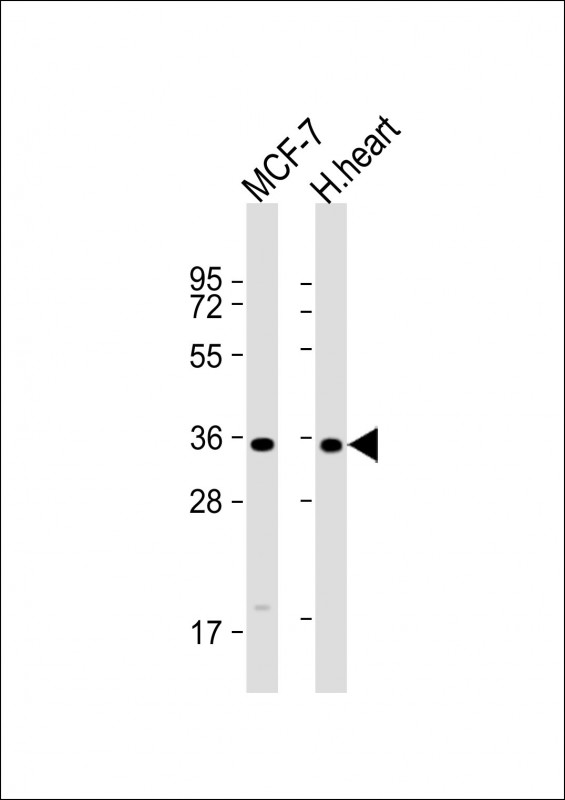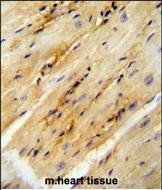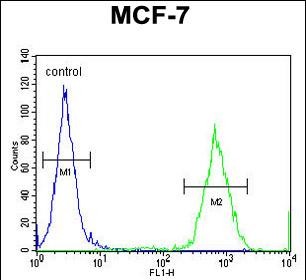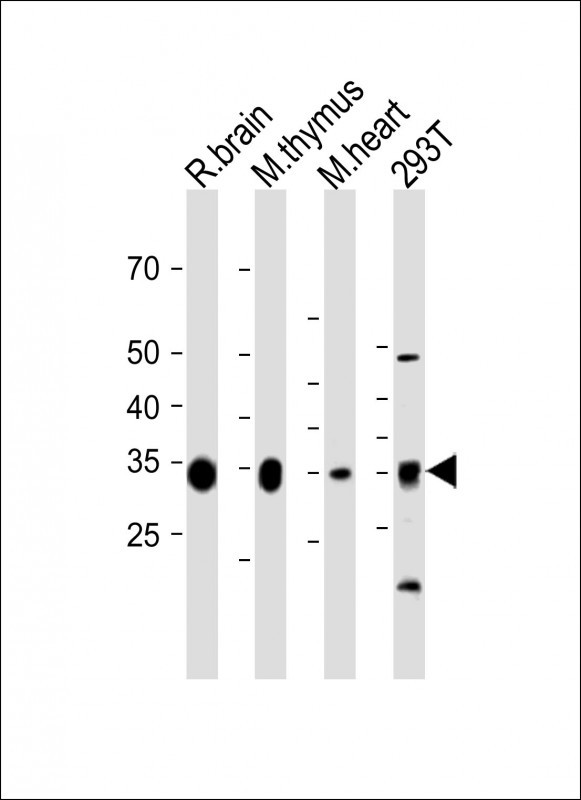GPD1L Antibody (N-term)
Affinity Purified Rabbit Polyclonal Antibody (Pab)
- SPECIFICATION
- CITATIONS: 1
- PROTOCOLS
- BACKGROUND

Application
| WB, IHC-P, FC, E |
|---|---|
| Primary Accession | Q8N335 |
| Other Accession | Q3ULJ0, NP_055956.1 |
| Reactivity | Human, Mouse |
| Host | Rabbit |
| Clonality | Polyclonal |
| Isotype | Rabbit IgG |
| Calculated MW | 38419 Da |
| Antigen Region | 44-73 aa |
| Gene ID | 23171 |
|---|---|
| Other Names | Glycerol-3-phosphate dehydrogenase 1-like protein, GPD1-L, GPD1L, KIAA0089 |
| Target/Specificity | This GPD1L antibody is generated from rabbits immunized with a KLH conjugated synthetic peptide between 44-73 amino acids from the N-terminal region of human GPD1L. |
| Dilution | WB~~1:2000 IHC-P~~1:50~100 FC~~1:10~50 E~~Use at an assay dependent concentration. |
| Format | Purified polyclonal antibody supplied in PBS with 0.09% (W/V) sodium azide. This antibody is purified through a protein A column, followed by peptide affinity purification. |
| Storage | Maintain refrigerated at 2-8°C for up to 2 weeks. For long term storage store at -20°C in small aliquots to prevent freeze-thaw cycles. |
| Precautions | GPD1L Antibody (N-term) is for research use only and not for use in diagnostic or therapeutic procedures. |
| Name | GPD1L (HGNC:28956) |
|---|---|
| Synonyms | KIAA0089 |
| Function | Plays a role in regulating cardiac sodium current; decreased enzymatic activity with resulting increased levels of glycerol 3- phosphate activating the DPD1L-dependent SCN5A phosphorylation pathway, may ultimately lead to decreased sodium current; cardiac sodium current may also be reduced due to alterations of NAD(H) balance induced by DPD1L. |
| Cellular Location | Cytoplasm. Note=Localized to the region of the plasma membrane |
| Tissue Location | Most highly expressed in heart tissue, with lower levels in the skeletal muscle, kidney, lung and other organs |

Provided below are standard protocols that you may find useful for product applications.
Background
The protein encoded by this gene catalyzes the conversion of sn-glycerol 3-phosphate to glycerone phosphate. The encoded protein is found in the cytoplasm, associated with the plasma membrane, where it binds the sodium channel, voltage-gated, type V, alpha subunit (SCN5A). Defects in this gene are a cause of Brugada syndrome type 2 (BRS2) as well as sudden infant death syndrome (SIDS).
References
Rose, J.E., et al. Mol. Med. 16 (7-8), 247-253 (2010) :
Liu, M., et al. Circ. Res. 105(8):737-745(2009)
Valdivia, C.R., et al. Am. J. Physiol. Heart Circ. Physiol. 297 (4), H1446-H1452 (2009) :
Makiyama, T., et al. Circ. J. 72(10):1705-1706(2008)
London, B., et al. Circulation 116(20):2260-2268(2007)
If you have used an Abcepta product and would like to share how it has performed, please click on the "Submit Review" button and provide the requested information. Our staff will examine and post your review and contact you if needed.
If you have any additional inquiries please email technical services at tech@abcepta.com.














 Foundational characteristics of cancer include proliferation, angiogenesis, migration, evasion of apoptosis, and cellular immortality. Find key markers for these cellular processes and antibodies to detect them.
Foundational characteristics of cancer include proliferation, angiogenesis, migration, evasion of apoptosis, and cellular immortality. Find key markers for these cellular processes and antibodies to detect them. The SUMOplot™ Analysis Program predicts and scores sumoylation sites in your protein. SUMOylation is a post-translational modification involved in various cellular processes, such as nuclear-cytosolic transport, transcriptional regulation, apoptosis, protein stability, response to stress, and progression through the cell cycle.
The SUMOplot™ Analysis Program predicts and scores sumoylation sites in your protein. SUMOylation is a post-translational modification involved in various cellular processes, such as nuclear-cytosolic transport, transcriptional regulation, apoptosis, protein stability, response to stress, and progression through the cell cycle. The Autophagy Receptor Motif Plotter predicts and scores autophagy receptor binding sites in your protein. Identifying proteins connected to this pathway is critical to understanding the role of autophagy in physiological as well as pathological processes such as development, differentiation, neurodegenerative diseases, stress, infection, and cancer.
The Autophagy Receptor Motif Plotter predicts and scores autophagy receptor binding sites in your protein. Identifying proteins connected to this pathway is critical to understanding the role of autophagy in physiological as well as pathological processes such as development, differentiation, neurodegenerative diseases, stress, infection, and cancer.




